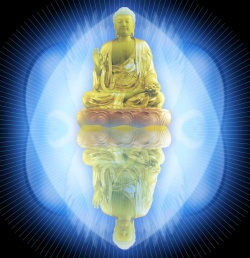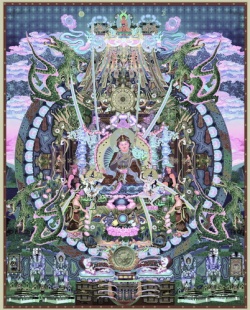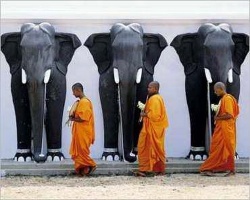The Satipaṭṭhāna Sutta for Recitation
The following is taken from Bhikkhu Anālayo’s translation (with modified headings).
1. Preface to the Satipaṭṭhāna Sutta
Thus have I heard. On one occasion the Blessed One was living in the Kuru country at a town of the Kurus named Kammāsadhamma.
There he addressed the monks thus: “Monks.” “Venerable Sir,” they replied. The Blessed One said this:
2. Statement that the path is direct
“Monks, this is the direct path for the purification of beings, for the surmounting of sorrow and lamentation, for the disappearance of dukkha and discontent, for acquiring the true method, for the realization of Nibbāna, namely, the four Satipaṭṭhānas.
3. Defining the practice of the four Satipaṭṭhānas
“What are the four? Here, monks, in regard to the body a monk abides contemplating the body, diligent, clearly knowing, and mindful, free from desires and discontent in regard to the world.
In regard to feelings he abides contemplating feelings, diligent, clearly knowing, and mindful, free from desires and discontent in regard to the world.
In regard to the mind he abides contemplating the mind, diligent, clearly knowing, and mindful, free from desires and discontent in regard to the world.
In regard to dhammas he abides contemplating dhammas, diligent, clearly knowing, and mindful, free from desires and discontent in regard to the world.
4. The breathing of the body
“And how, monks, does he in regard to the body abide contemplating the body? Here, gone to the forest, or to the root of a tree, or to an empty hut, he sits down;
having folded his legs crosswise, set his body erect, and established mindfulness in front of him, mindful he breathes in, mindful he breathes out.
“Breathing in long, he knows ‘I breathe in long,’ breathing out long, he knows ‘I breathe out long.’
Breathing in short, he knows ‘I breathe in short,’ breathing out short, he knows ‘I breathe out short.’ He trains thus: ‘I shall breathe in experiencing the whole body.’
He trains thus: ‘I shall breathe out experiencing the whole body.’
He trains thus: ‘I shall breathe in calming the bodily formation,’ he trains thus: ‘I shall breathe out calming the bodily formation.’
“Just as a skilled turner or his apprentice, when making a long turn, knows, ‘I make a long turn,’ or when making a short turn knows, ‘I make a short turn’ so too, breathing out long, he knows ‘I breathe in long,’...(continue as above).
Refrain
“In this way, in regard to the body he abides contemplating the body internally, or he abides contemplating the body externally, or he abides contemplating the body both internally and externally.
He abides contemplating the nature of arising in the body, or he abides contemplating the nature of passing away in the body, or he abides contemplating the nature of both arising and passing away in the body.
Mindfulness that ‘there is a body’ is established in him to the extent necessary for bare knowledge and continuous mindfulness. And he abides independent, not clinging to anything in the world.
“That is how in regard to the body he abides contemplating the body.
5. The postures of the body
“Again, monks, when walking, he knows, ‘I am walking’; when standing, he knows, ‘I am standing’; when sitting, he knows, ‘I am sitting’; when lying down, he knows, ‘I am lying down’; or he knows accordingly however his body is disposed.
Refrain
“In this way, in regard to the body he abides contemplating the body internally, or he abides contemplating the body externally, or he abides contemplating the body both internally and externally.
He abides contemplating the nature of arising in the body, or he abides contemplating the nature of passing away in the body, or he abides contemplating the nature of both arising and passing away in the body.
Mindfulness that ‘there is a body’ is established in him to the extent necessary for bare knowledge and continuous mindfulness.
And he abides independent, not clinging to anything in the world.
“That too is how in regard to the body he abides contemplating the body.
6. The activities of the body
“Again, monks, when going forward and returning he acts clearly knowing;
when looking ahead and looking away he acts clearly knowing; when flexing and extending his limbs he acts clearly knowing;
when wearing his robes and carrying his outer robe he acts clearly knowing;
when eating, drinking, consuming food, and tasting he acts clearly knowing;
when defecating and urinating he acts clearly knowing;
when walking, standing, sitting, falling asleep, waking up, talking, and keeping silent he acts clearly knowing.
Refrain
“In this way, in regard to the body he abides contemplating the body internally ...externally ... both internally and externally.
He abides contemplating the nature of arising ... of passing away ... of both arising and passing away in the body.
Mindfulness that ‘there is a body’ is established in him to the extent necessary for bare knowledge and continuous mindfulness.
And he abides independent, not clinging to anything in the world.
That too is how in regard to the body he abides contemplating the body.
7. The anatomy of the body
“Again, monks, he reviews this same body up from the soles of the feet and down from the top of the head, enclosed by skin, as full of many kinds of impurity thus:‘in this body there are head-hairs, body-hairs, nails, teeth, skin, flesh, sinews, bones, bone-marrow, kidneys, heart, liver, diaphragm, spleen, lungs, bowels, mesentery, contents of the stomach, farces, bile, phlegm, pus, blood, sweat, fat, tears, grease, spittle, snot, oil of the joints, and urine.’
“Just as though there were a bag with an opening at both ends full of many sorts of grain, such as hill rice, red rice, beans, peas, millet, and white rice, and a man with good eyes were to open it and review it thus:
‘this is hill rice, this is red rice, these are beans, these are peas, this is millet, this is white rice’; so too he reviews this same body... (up from the soles of the feet... oil of the joints, and urine)’.
Refrain
“In this way, in regard to the body he abides contemplating the body internally, or he abides contemplating the body externally, or he abides contemplating the body both internally and externally.
He abides contemplating the nature of arising in the body, or he abides contemplating the nature of passing away in the body, or he abides contemplating the nature of both arising and passing away in the body. Mindfulness that ‘there is a body’ is established in him to the extent necessary for bare knowledge and continuous mindfulness.
And he abides independent, not clinging to anything in the world.
“That too is how in regard to the body he abides contemplating the body.
8. The body as the four elements
“Again, monks, he reviews this same body, however it is placed, however disposed, as consisting of elements thus: ‘in this body there are the earth element, the water element, the fire element, and the air element’.
“Just as though a skilled butcher or his apprentice had killed a cow and was seated at the crossroads with it cut up into pieces; so too he reviews this same body... (up from the soles of the feet... oil of the joints, and urine)’.
Refrain
“In this way, in regard to the body he abides contemplating the body internally, or he abides contemplating the body externally, or he abides contemplating the body both internally and externally.
He abides contemplating the nature of arising in the body, or he abides contemplating the nature of passing away in the body, or he abides contemplating the nature of both arising and passing away in the body.
Mindfulness that ‘there is a body’ is established in him to the extent necessary for bare knowledge and continuous mindfulness. And he abides independent, not clinging to anything in the world.
“That too is how in regard to the body he abides contemplating the body.
9. Appearance of the body when dead
“Again, monks, as though he were to see a corpse thrown aside in a charnel ground – one, two, or three days dead, bloated, livid, and oozing matter...being devoured by crows, hawks, vultures, dogs, jackals, or various kinds of worms...
a skeleton with flesh and blood, held together with sinews... a fleshless skeleton smeared with blood, held together with sinews ...
a skeleton without flesh and blood, held together with sinews... disconnected bones scattered in all directions... bones bleached white, the colour of shells... bones heaped up, more than a year old...
bones rotten and crumbing to dust... he compares this same body with it thus: ‘this body too is of the same nature, it will be like that, it is not exempt from that fate.’
Refrain
“In this way, in regard to the body he abides contemplating the body internally, or he abides contemplating the body externally, or he abides contemplating the body both internally and externally.
He abides contemplating the nature of arising in the body, or he abides contemplating the nature of passing away in the body, or he abides contemplating the nature of both arising and passing away in the body.
Mindfulness that ‘there is a body’ is established in him to the extent necessary for bare knowledge and continuous mindfulness. And he abides independent, not clinging to anything in the world.
“That too is how in regard to the body he abides contemplating the body.
10. Feeling
“And how, monks, does he in regard to feelings abide contemplating feelings?
“Here, when feeling a pleasant feeling, he knows, ‘I feel a pleasant feeling’; when feeling an unpleasant feeling he knows, ‘I feel an unpleasant feeling’; when feeling a neutral feeling, he knows, ‘I feel a neutral feeling.’
“When feeling a worldly pleasant feeling he knows, ‘I feel a worldly pleasant feeling’; when feeling an unworldly pleasant feeling, he knows, ‘I feel an unworldly pleasant feeling’;
when feeling a worldly unpleasant feeling he knows, ‘I feel a worldly unpleasant feeling’; when feeling an unworldly unpleasant feeling, he knows, ‘I feel an unworldly unpleasant feeling’;
when feeling a worldly neutral feeling he knows, ‘I feel a worldly neutral feeling’; when feeling an unworldly neutral feeling, he knows, ‘I feel an unworldly neutral feeling.’
Refrain
“In this way, in regard to feelings he abides contemplating feelings internally...externally... internally and externally.
He abides contemplating the nature of arising... of passing away... of both arising and passing away in feelings.
Mindfulness that ‘there is feeling’ is established in him to the extent necessary for bare knowledge and continuous mindfulness. And he abides independent, not clinging to anything in the world.
“That too is how in regard to feelings he abides contemplating feelings.
11. Mind
“And how, monks, does he in regard to the mind abide contemplating the mind?
“Here he knows a lustful mind to be ‘lustful’, and a mind without lust to be ‘without lust’; he knows an angry mind to be ‘angry’, and a mind without anger to be ‘without anger’;
he knows a deluded mind to be ‘deluded’, and a mind without delusion to be ‘without delusion’; he knows a contracted mind to be ‘contracted’, and a distracted mind to be ‘distracted’;
he knows a great mind to be ‘great’, and a narrow mind to be ‘narrow’; he knows a surpassable mind to be ‘surpassable’ and unsurpassable mind to be ‘unsurpassable’; he knows a concentrated mind to be ‘concentrated’, and an unconcentrated mind to be ‘unconcentrated’; he knows a liberated mind to be ‘liberated’, and an unliberated mind to be ‘unliberated.’
Refrain
“In this way, in regard to the mind he abides contemplating the mind internally...externally... internally and externally.
He abides contemplating the nature of arising... of passing away... of both arising and passing away in regard to the mind.
Mindfulness that ‘there is a mind’ is established in him to the extent necessary for bare knowledge and continuous mindfulness.
And he abides independent, not clinging to anything in the world.
“That too is how in regard to the mind he abides contemplating the mind.
12. Mind: the Five Hindrances
“And how, monks, does he in regard to dhammas abide contemplating dhammas?
Here in regard to dhammas he abides contemplating dhammas in terms of the five hindrances.
And how does he in regard to dhammas abide contemplating dhammas in terms of the five hindrances?
“If sensual desire is present in him, he knows, ‘there is sensual desire in me’; if sensual desire is not present in him, he knows, ‘there is no sensual desire in me’;
and he knows how unarisen sensual desire can arise, how arisen sensual desire can be removed, and how a future arising of the removed sensual desire can be prevented.
“If aversion is present in him, he knows, ‘there is aversion in me’; if aversion is not present in him, he knows, ‘there is no aversion in me’; and he knows how unarisen aversion can arise, how arisen aversion can be removed, and how a future arising of the removed aversion can be prevented.
“If sloth-and-torpor is present in him, he knows, ‘there is sloth-and-torpor in me’;
if sloth-and-torpor is not present in him, he knows, ‘there is no sloth-and-torpor in me’;
and he knows how unarisen sloth-and-torpor can arise, how arisen sloth-and-torpor can be removed, and how a future arising of the removed sloth-and- torpor can be prevented.
“If restlessness-and-worry is present in him, he knows, ‘there is restlessness-and-worry in me’;
if restlessness-and-worry is not present in him, he knows, ‘there is no restlessness-and-worry in me’;
and he knows how unarisen restlessness-and-worry can arise, how arisen restlessness-and-worry can be removed, and how a future arising of the removed restlessness-and-worry can be prevented.
“If doubt is present in him, he knows, ‘there is doubt in me’; if doubt is not present in him, he knows, ‘there is no doubt in me’; and he knows how unarisen doubt can arise, how arisen doubt can be removed, and how a future arising of the removed doubt can be prevented.
Refrain
“In this way, in regard to dhammas he abides contemplating dhammas internally...externally... both internally and externally.
He abides contemplating the nature of arising... of passing away... of both arising and passing away in dhammas.
Mindfulness that ‘there are dhammas’ is established in him to the extent necessary for bare knowledge and continuous mindfulness. And he abides independent, not clinging to anything in the world.
“That too is how in regard to dhammas he abides contemplating dhammas in terms of the five hindrances.
13. Mind: the Five Skandhas
“Again, monks, in regard to dhammas he abides contemplating dhammas in terms of the five aggregates of clinging. And how does he in regard to dhammas abide contemplating dhammas in terms of the five aggregates of clinging?
Here he knows, ‘such is material form, such its arising, such its passing away; such is feeling, such its arising, such its passing away; such is cognition,
such its arising, such its passing away; such are volitions, such their arising, such their passing away; such is consciousness, such its arising, such its passing away.’
Refrain
“In this way, in regard to dhammas he abides contemplating dhammas internally...externally... both internally and externally.
He abides contemplating the nature of arising ... of passing away... of both arising and passing away in dhammas.
Mindfulness that ‘there are dhammas’ is established in him to the extent necessary for bare knowledge and continuous mindfulness.
And he abides independent, not clinging to anything in the world.
“That too is how in regard to dhammas he abides contemplating dhammas in terms of the five aggregates of clinging.
14. Mind: the [Six Internal and External Sense-spheres
“Again, monks, in regard to dhammas he abides contemplating dhammas in terms of the six internal and external sense-spheres.
And how does he in regard to dhammas abide contemplating dhammas in terms of the six internal and external sense-spheres?
“Here he knows the eye, he knows forms, and he knows the fetter that arises dependent on them both, and he also knows how an unarisen fetter can arise, how an arisen fetter can be removed, and how a future arising of the removed fetter can be prevented.
“He knows the ear, he knows sounds, and he knows the fetter that arises dependent on them both, and he also knows how an unarisen fetter can arise, how an arisen fetter can be removed, and how a future arising of the removed fetter can be prevented.
“He knows the nose, he knows odours, and he knows the fetter that arises dependent on them both, and he also knows how an unarisen fetter can arise, how an arisen fetter can be removed, and how a future arising of the removed fetter can be prevented.
“He knows the tongue, he knows flavours, and he knows the fetter that arises dependent on them both, and he also knows how an unarisen fetter can arise, how an arisen fetter can be removed, and how a future arising of the removed fetter can be prevented.
“He knows the body, he knows tangibles, and he knows the fetter that arises dependent on them both, and he also knows how an unarisen fetter can arise, how an arisen fetter can be removed, and how a future arising of the removed fetter can be prevented.
“He knows the mind, he knows mind-objects, and he knows the fetter that arises dependent on them both, and he also knows how an unarisen fetter can arise, how an arisen fetter can be removed, and how a future arising of the removed fetter can be prevented.
Refrain
“In this way, in regard to dhammas he abides contemplating dhammas internally ...externally ... both
internally and externally.
He abides contemplating the nature of arising ... of passing away ... of both arising and passing away in dhammas.
Mindfulness that ‘there are dhammas’ is established in him to the extent necessary for bare knowledge and
continuous mindfulness.
And he abides independent, not clinging to anything in the world.
“That too is how in regard to dhammas he abides contemplating dhammas in terms of the six internal and external sense-spheres.
15: Dhammas: the Seven Factors of Awakening
“Again, monks, in regard to dhammas he abides contemplating dhammas in terms of the seven awakening factors. And how does he in regard to dhammas abide contemplating dhammas in terms of the seven awakening factors?
“Here, if the mindfulness awakening factor is present in him, he knows, ‘there is the mindfulness awakening factor in me’; if the mindfulness awakening factor is not present in him, he knows,
‘there is no mindfulness awakening factor in me’; he knows how the unarisen mindfulness factor of awakening can arise, and how the arisen mindfulness factor can be perfected by development.
“If the investigation-of-dhammas awakening factor is present in him, he knows, ‘there is the investigation- of-dhammas awakening factor in me’; if the investigation-of-dhammas awakening factor is not present in him,
he knows, ‘there is no investigation-of-dhammas awakening factor in me’; he knows how the unarisen investigation-of-dhammas factor of awakening can arise, and how the arisen investigation-of-dhammas factor can be perfected by development.
“If the energy awakening factor is present in him, he knows, ‘there is the energy awakening factor in me’; if the energy awakening factor is not present in him, he knows,‘there is no energy awakening factor in me’;
he knows how the unarisen energy factor of awakening can arise, and how the arisen energy factor can be perfected by development.
“If the joy awakening factor is present in him, he knows, ‘there is the joy awakening factor in me’; if the joy awakening factor is not present in him, he knows,
‘there is no joy awakening factor in me’; he knows how the unarisen joy factor of awakening can arise, and how the arisen joy factor can be perfected by development.
“If the tranquillity awakening factor is present in him, he knows, ‘there is the tranquillity awakening factor in me’; if the tranquillity awakening factor is not present in him,
he knows, ‘there is no tranquillity awakening factor in me’; he knows how the unarisen tranquillity factor of awakening can arise, and how the arisen tranquillity factor can be perfected by development.
“If the concentration awakening factor is present in him, he knows, ‘there is the concentration awakening factor in me’; if the concentration awakening factor is not present in him, he knows,
‘there is no concentration awakening factor in me’; he knows how the unarisen concentration factor of awakening can arise, and how the arisen concentration factor can be perfected by development.
“If the equanimity awakening factor is present in him, he knows, ‘there is the equanimity awakening factor in me’; if the equanimity awakening factor is not present in him, he knows, ‘there is no equanimity awakening factor in me’;
he knows how the unarisen equanimity factor of awakening can arise, and how the arisen equanimity factor can be perfected by development.
Refrain
“In this way, in regard to dhammas he abides contemplating dhammas internally...externally... both internally and externally. He abides contemplating the nature of arising... of passing away... of both arising and passing away in dhammas.
Mindfulness that ‘there are dhammas’ is established in him to the extent necessary for bare knowledge and continuous mindfulness.
And he abides independent, not clinging to anything in the world.
“That too is how in regard to dhammas he abides contemplating dhammas in terms of the seven awakening factors.
16: Dhammas: the Four Noble Truths
“Again, monks, in regard to dhammas he abides contemplating dhammas in terms of the four noble truths.
And how does he in regard to dhammas abide contemplating dhammas in terms of the four noble truths?
“Here he knows as it really is, ‘this is dukkha ’; he knows as it really is, ‘this is the arising of dukkha ’; he knows as it really is, ‘this is the cessation of dukkha’; he knows as it really is, ‘this is the way leading to the cessation of dukkha.’
Refrain
“In this way, in regard to dhammas he abides contemplating dhammas internally...externally... both internally and externally. He abides contemplating the nature of arising... of passing away... of both arising and passing away in dhammas.
Mindfulness that ‘there are dhammas’ is established in him to the extent necessary for bare knowledge and continuous mindfulness. And he abides independent, not clinging to anything in the world.
“That too is how in regard to dhammas he abides contemplating dhammas in terms of the four noble truths. 17: The Prediction to Awakening
“Monks, if anyone should develop these four Satipaṭṭhānas in such a way for seven years, one of two fruits could be expected for him: either final knowledge here and now, or, if there is a trace of clinging left, non- returning. Let alone seven years... six years... five years... four years... three years... two years... one year... seven months... six months... five months... four months... three months... two months... one month... half a month... if anyone should develop these four Satipaṭṭhānas in such a way for seven days, one of two fruits could be expected for him: either final knowledge here and now, or, if there is a trace of clinging left, non-returning. So it was with reference to this that it was said:
18: Reaffirmation that the path is direct
“Monks, this is the direct path for the purification of beings, for the surmounting of sorrow and lamentation, for the disappearance of dukkha and discontent, for acquiring the true method, for the realization of Nibbāna, namely, the four Satipaṭṭhānas.”
That is what the Blessed One said. The monks were satisfied and delighted in the Blessed One’s words




















